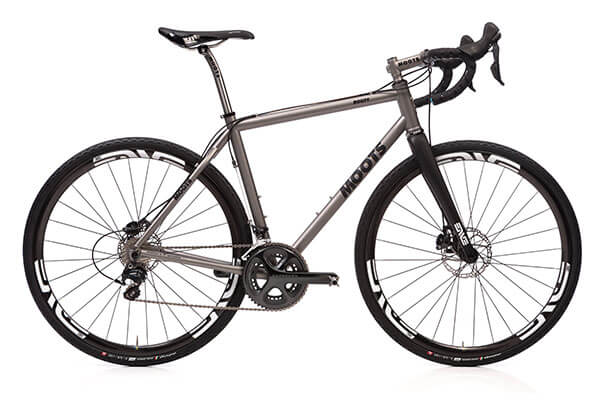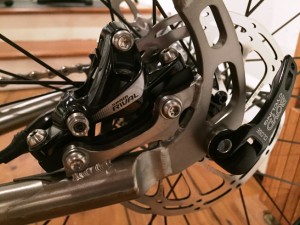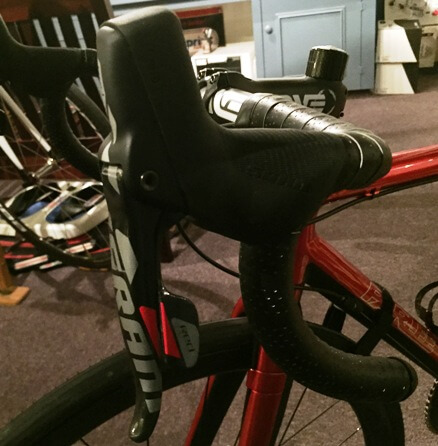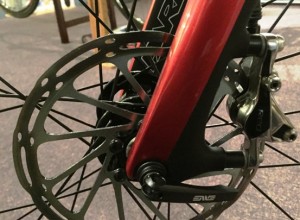Hydraulic Road Disc Brakes – Shimano RS785/685 and SRAM Hydro Review & Comparison
By Jim Weaver, Service Manager, Fit Werx, VT
2014 may stand as the year where the most new bikes and products have crossed the work stands of Fit Werx’s technicians in MA, NYC/NJ and VT. One of the most significant new product categories over the past year has been hydraulic road disc brake systems from Shimano and SRAM. After initial supply problems, Shimano’s RS785 hydraulic system was released in the middle of the summer and SRAM introduced its redesigned “Hydro 22” hydraulic disc road brakes after the first generation product suffered a recall which took the product off the shelf for the start of the year. We have built quite a number of bikes equipped with each of these systems as gravel grinder and other wide tire capable endurance bikes like Moots’ ROUTT are fantastic for exploring gravel or paved roads in Vermont, Massachusetts, New Jersey and beyond while high performance lightweight disc brake equipped bikes like Parlee’s Altium Disc grow in popularity. Now that we have ample experience with the latest disc brake systems from Shimano and SRAM, here are my impressions. 
Both the SRAM and Shimano systems confirm the previously theoretical advantages of hydraulic disc brakes on a road bike. Hydraulic disc brakes offer superior braking performance in all conditions, including rain. Hydraulic disc brakes like SRAM’s Hydro 22 and Shimano’s RS785 and RS685 are more responsive and progressive than cable brakes as there is no cable stretch or housing flex to rob power or return. In addition, a well designed disc brake can dissipate heat better than a rim brake as heat from braking is transferred to the disc rotor, rather than into the rim of the wheel. Too much heat on a rim can expand the air in the tube of a clincher tire and cause it to burst. If this happens on a really long descent where the rider drags the brakes too much, you can imagine that it is a problem… This is not an abstract problem, I have seen this happen. The top manufacturers of quality carbon rims have been working on this issue for quite some time and systems like Mavic’s TgMax rims have helped with heat issues overall. However, the reality is that transferring heat to the rotor instead of the rim eliminates the potential of any rim related heat problems.
Unlike a cable brake, the amount of braking force with a hydraulic disc brake is not determined by how hard you squeeze the brake lever, but only by how far you pull the lever. The further you pull the lever, the more the hydraulic system is pressurized, and thus the harder the brake pads press against the brake rotor. Overall braking effort, even in emergency situations, is greatly reduced with a well designed hydraulic brake system and modulation is also very good.
 Road hydraulic disc brakes require a different approach to set-up and break-in than a caliper brake. For example, you have to “bed-in” the brake pads for the brakes to work as designed and not feel weak. This is no big deal, but is something alien to users of conventional caliper brakes. To “bed-in” pads and rotors, accelerate up to speed, usually around 15 mph, and then brake hard, but do not come to a complete stop. Repeat this process 10 or 15 times. It is interesting to note the improvement in brake performance with each cycle of this process. When you first start the brakes will often feel soft and weak, after you finish the brakes will have a very strong and progressive feel. Disc brakes can make noises, from occasional squealing, to clicking noises, to ever-so-slight rubbing of the disc on the pads when the wheel is spinning freely. From a care perspective, just like with rim brakes, you must be careful not to allow the brake discs or pads to become contaminated by oil, hydraulic fluid, and other chemicals as it will soak into the pads and can render the pads far less effective. These are all minor problems that vanish after initial set-up and break-in, but are good to be aware as they are simply different from what is experienced with a caliper brake.
Road hydraulic disc brakes require a different approach to set-up and break-in than a caliper brake. For example, you have to “bed-in” the brake pads for the brakes to work as designed and not feel weak. This is no big deal, but is something alien to users of conventional caliper brakes. To “bed-in” pads and rotors, accelerate up to speed, usually around 15 mph, and then brake hard, but do not come to a complete stop. Repeat this process 10 or 15 times. It is interesting to note the improvement in brake performance with each cycle of this process. When you first start the brakes will often feel soft and weak, after you finish the brakes will have a very strong and progressive feel. Disc brakes can make noises, from occasional squealing, to clicking noises, to ever-so-slight rubbing of the disc on the pads when the wheel is spinning freely. From a care perspective, just like with rim brakes, you must be careful not to allow the brake discs or pads to become contaminated by oil, hydraulic fluid, and other chemicals as it will soak into the pads and can render the pads far less effective. These are all minor problems that vanish after initial set-up and break-in, but are good to be aware as they are simply different from what is experienced with a caliper brake.
 While hydraulic brakes are great from a long-term maintenance standpoint as they eliminate the friction and cable maintenance that is required due to corrosion in long runs of metal cables sliding in metal housing, from an installation standpoint, hydraulic disc brakes are far more complicated than most cable actuated brakes (disc or caliper). Hoses have to be cut to length, barbs and olives installed (alien terms for non-mountain bikers), hoses tightened, and brakes bled of air in the hydraulic line, sometimes repeatedly. Needless to say, the installation of these brakes takes much, much longer than cable-actuated brakes, and is far messier! I have already installed the SRAM Hydro 22 system on a Kelly Bedford/K.Bedford Customs Tig frame that required the brake hose to be run fully concealed inside the frame. The end result was a very finished looking bike, but the installation was no picnic. For this reason, dealers have to stock a whole new variety of brake parts (those barbs and olives again), not to mention bleed kits and various brake fluids that are particular to each brand. For example, Shimano’s system requires use of Shimano’s mineral oil – if you use some other mineral oil, your warranty is void – while, SRAM uses DOT 5.1 brake fluid (the same stuff used in your car). All of these are my concern as the bike builder, not yours as the end user, but it is to be noted that if you are a “do it yourself” mechanic, expect a learning curve and to encounter problems unlike anything you have seen on a road bike before during installation. If a qualified Fit Werx technician installs your hydraulic brakes on your disc brake ready bike, all you need to know is that, once the pads fully “bed”, the system will work very well indeed, in all conditions.
While hydraulic brakes are great from a long-term maintenance standpoint as they eliminate the friction and cable maintenance that is required due to corrosion in long runs of metal cables sliding in metal housing, from an installation standpoint, hydraulic disc brakes are far more complicated than most cable actuated brakes (disc or caliper). Hoses have to be cut to length, barbs and olives installed (alien terms for non-mountain bikers), hoses tightened, and brakes bled of air in the hydraulic line, sometimes repeatedly. Needless to say, the installation of these brakes takes much, much longer than cable-actuated brakes, and is far messier! I have already installed the SRAM Hydro 22 system on a Kelly Bedford/K.Bedford Customs Tig frame that required the brake hose to be run fully concealed inside the frame. The end result was a very finished looking bike, but the installation was no picnic. For this reason, dealers have to stock a whole new variety of brake parts (those barbs and olives again), not to mention bleed kits and various brake fluids that are particular to each brand. For example, Shimano’s system requires use of Shimano’s mineral oil – if you use some other mineral oil, your warranty is void – while, SRAM uses DOT 5.1 brake fluid (the same stuff used in your car). All of these are my concern as the bike builder, not yours as the end user, but it is to be noted that if you are a “do it yourself” mechanic, expect a learning curve and to encounter problems unlike anything you have seen on a road bike before during installation. If a qualified Fit Werx technician installs your hydraulic brakes on your disc brake ready bike, all you need to know is that, once the pads fully “bed”, the system will work very well indeed, in all conditions.
Any other considerations? Hydraulic road disc brake bikes weigh more than an equivalently equipped caliper brake bike. In a day where some manufacturers brag that their frame is all of 25 grams (less than a standard USPS letter) lighter than their competitor’s, adding a pound (~ 452 grams) of weight becomes a talking point. Hydraulic disc brake systems are also more expensive than conventional caliper brakes. For example, SRAM’s Red 22 Hydraulic system is about $300 more than the caliper brake equipped Red group. Finally, for those focused on aero, disc brake systems are not as aerodynamic as caliper brakes, especially when the calipers are hidden behind the fork or behind the bottom bracket. For this reason, there are currently almost no disc brake equipped TT and tri bikes on the market (although there are some hydraulic caliper brake tri bikes available, like Cervelo’s 2015 P3 Ultegra).
While you can adjust the overall lever reach on the new hydraulic brake levers (like their caliper counterparts), you cannot adjust the amount of lever movement before the brakes start to engage. You have to pull the lever a bit further than I like for the brakes to engage. However, many riders like this type of feel. So, this is simply a matter of preference and does not affect the actual stopping performance of the brakes. Hopefully both SRAM and Shimano can figure out a way to incorporate a light weight lever adjustment into future designs.
When it comes to the shifting compatibility of the hydraulic systems on the market, Shimano’s system is available with Di2 electronic shifting compatible shifters in their RS785 lever or hydraulic brakes with mechanical/cable shifting in the RS685 unit. Shimano’s cyclocross based BR-CX77 mechanical disc caliper will also work with most any cable based road brake lever, but it is not a hydraulic brake. All of SRAM’s shifting systems are cable-actuated, as SRAM is working on a wireless electronic shift system, but has not released it yet. SRAM offers hydraulic brakes in its top three road groups: Red 22 Hydro, Force 22 Hydro, and Rival 22 Hydro (the 22 indicating that there are 11 cogs in the rear cassette, for a total of 22 “speeds”). I certainly will not try to decide which brand is better, SRAM or Shimano. While the brakes feel and operate slightly different, both function great.
 From an ergonomics standpoint, the brake hoods of the SRAM look a bit oversized and tall as they must accommodate the brake master cylinder plus the mechanicals for cable shifting. Despite the new look, the brake hoods feel very good and are quite comfortable in hand. Shimano’s brake hoods are smaller than SRAM’s with the RS785 Di2 version not looking much different from the caliper brake version and the RS685 cable shift version having a taller top that is more like SRAM’s hydro lever shape. As with SRAM, they have a comfortable shape and the ergonomics are very good.
From an ergonomics standpoint, the brake hoods of the SRAM look a bit oversized and tall as they must accommodate the brake master cylinder plus the mechanicals for cable shifting. Despite the new look, the brake hoods feel very good and are quite comfortable in hand. Shimano’s brake hoods are smaller than SRAM’s with the RS785 Di2 version not looking much different from the caliper brake version and the RS685 cable shift version having a taller top that is more like SRAM’s hydro lever shape. As with SRAM, they have a comfortable shape and the ergonomics are very good.
When it comes to actual brake feel, Shimano and SRAM’s systems do feel slightly different when you apply the brakes. To me, it seems as though the lever travel with the SRAM is not as long as the Shimano’s, giving the impression of crisper action, but this is only my impression. All of SRAM’s Hydro brake levers and Shimano’s RS785 or RS685 brake levers offer reach adjustments for those with smaller hands. Interestingly, Shimano’s brake/shifters are not designated as Ultegra, Dura Ace, or 105 at this time. This allows Shimano to make just two versions that can be used in conjunction with any 11 speed Shimano shift system.
As for the future, if you buy a hydraulic disc brake road bike at this time, I do not believe you will be saddled with a dinosaur in two or three years. While there will always be improvements in forthcoming generations, these systems are refined and here to stay. You will see more and more disc brake road bikes available each year going forward. There is even rumor that Campagnolo is working with For mula, a manufacturer of hydraulic mountain bike brakes, to introduce a system, possibly in 2016 and compatible road disc wheels are starting to spring up like dandelions on a New England lawn in May. All of the major wheel manufacturers have disc compatible wheels in their lineups, including Corima, Zipp, Enve, Mavic, Easton and Boyd, and prices run from $300 for a set of Mavic Aksium One Disc wheels to $3,050 for a wonderful set of Enve SES 3.4 carbon disc wheels with Chris King hubs, with a lot of stops in between. So, there is a wide variety of wheels available at a wide variety of price levels, with more to come.
mula, a manufacturer of hydraulic mountain bike brakes, to introduce a system, possibly in 2016 and compatible road disc wheels are starting to spring up like dandelions on a New England lawn in May. All of the major wheel manufacturers have disc compatible wheels in their lineups, including Corima, Zipp, Enve, Mavic, Easton and Boyd, and prices run from $300 for a set of Mavic Aksium One Disc wheels to $3,050 for a wonderful set of Enve SES 3.4 carbon disc wheels with Chris King hubs, with a lot of stops in between. So, there is a wide variety of wheels available at a wide variety of price levels, with more to come.
Disc brakes are not just for dirt road bikes; you are going to see more and more hydraulic brake-equipped road bikes appearing on the pavement too and prices are already coming down. Felt’s Z4 Disc is a pavement specific disc road bike that is equipped with SRAM Rival Hydro and starts at $2500 while the just introduced wide tire capable Jamis Renegade line of endurance road bikes also starts under $2500 (Felt and Jamis bikes are both available through Fit Werx bike shops in VT, MA and NYC/NJ). If having tire width options and maximizing your stopping power and consistency of braking in all weather conditions is of higher value than having the absolute lightest bike, a hydraulic disc brake equipped bike is a worthy consideration. Fit Werx will be glad to help you with any questions you may have about bikes equipped with road hydraulic disc brakes, so don’t hesitate to call, email or post to Facebook.

